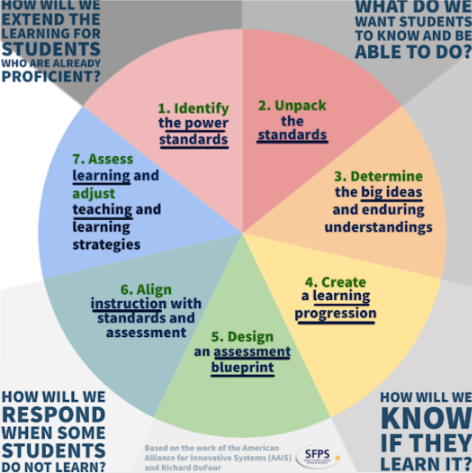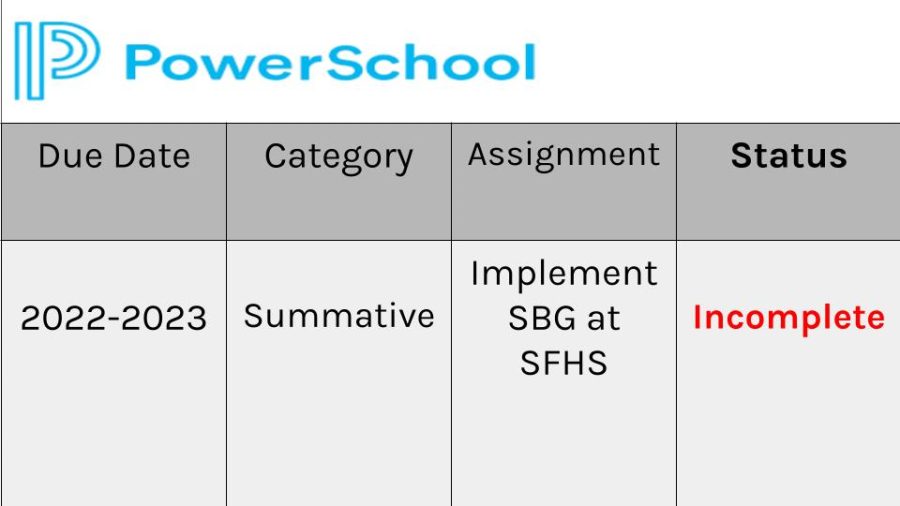Standards Based Grading: A Work in Progress
May 23, 2023
At the conclusion of Standards Based Grading’s first year at Santa Fe High School, the new system has earned an ‘incomplete’ grade of its own.
While teachers and administrators have been scrambling to implement and learn SBG on the job, savvy students have already learned to manipulate and maneuver their way around the new grade book, finding new ways to coast.
“It’s easier to do less and maintain a better grade [in SBG],” said Greely Miller, a junior at SFHS when comparing it to traditional systems.
Meanwhile, teachers and administrators are trying to change the tires on a moving bus.
SBG’s identity has been largely dominated by its unfamiliar four-point grading scale. In reality, SBG is a systematic approach to an educational theory that has been in development for decades.
Educators have been searching for a method of standardization to the achievement of education and measurement of growth for a long time, and in theory, SBG looks like a step in the right direction.
Under SBG, grades are meant to reflect what a student has learned objectively, rather than a grade they earned subjectively. Thus, classroom behavior, extra credit work, and other factors that don’t necessarily demonstrate learning become obsolete in the gradebook. The ultimate goal for this system is to universalize what students must learn to receive an “A” in each class regardless of which teacher is punching in the grades.
Proponents of SBG also claim that the grading system provides a greater depth of feedback for students. Rather than simply receiving a one-dimensional 0-100 grade, students are assessed on each of the clearly articulated learning standards so they can pinpoint areas of weakness.
“I really agree with the concept that learning is not one-and-done – it’s cyclical,” said Kate Gomez, Santa Fe High’s digital learning coach. “A lot of our teachers already had that philosophy.”
All assessments of the learning standards are classified as either summative or formative. Summative assessments account for 90 percent of the student’s final grade while formative assessments only hold a 10 percent stake. To many students, this has opened a window to an easy workaround from doing formative assessments such as homework.
“You can miss 20 assignments but ace your summatives and get a 90 percent,” said graduating senior Benito Elsbrock.
Many students take advantage of this loophole and play the game of school rather than focus on growth and learning – the issue that SBG was trying to address in the first place.
Meanwhile, some teachers have found a workaround around the workaround. For example, Mr. Tafoya, a math teacher who has taught at SFHS for 35 years, countered this situation by making every single assignment count as summative.
Santa Fe High’s instructional coach Mrs. Romp, who has played a big part in the implementation of SBG at SFHS, claims that revisions to the grading process next year won’t allow for that formative-summative exploit.
“Next year that is not going to be the case,” she asserted. “One will not weigh higher than the other. The teachers will be able to choose which assessments best cover the given standard, and that will go forward [into Powerschool].”
Santa Fe Public Schools has contracted with a New York-based organization of educational consultants to assist in the implementation of SBG in the district. Since March 2021, the American Alliance for Innovative Systems (AAIS) has been training teachers and administrators to master SBG, who are then expected to instruct their colleagues.

AAIS has been guiding the district through a seven-step cycle which can be seen in this graphic. The instruction and collaboration within this pathway — selecting priority standards, deciding how they will be sequenced throughout the year, and writing proficiency scales — is nearly complete. AAIS is currently working with SFPS through the final stage, which is to assess learning and adjust teaching and learning strategies.
David Holden, the CEO of AAIS, said these concepts of improved learning and instruction cannot be achieved simply through the four-point grading system. “It isn’t as easy as just changing the gradebook,” asserted Mr. Holden in an interview with the Demon Tattler. “It’s a philosophical shift in the way we teach.”
Once SFPS had committed to SBG, they were left with a choice: The district could have either adopted existing materials from other education professionals, or developed their own to tailor SBG to SFPS.
While the first option seems to be more direct, and less time consuming, the district elected to place the formation of proficiency scales, etc., in the hands of SFPS teachers and administrators. The idea was that the opportunity to construct the future of their classes would promote buy-in from teachers and administrators.
However, this new responsibility can feel like a burden to many teachers as they have to devote time outside of their regular teaching activities to forming and agreeing on these standards, sequences, and scales with other teachers, along with navigating the new expectations from them inside of the classroom.
To ensure that every teacher of every subject feels that the learning standards accurately represent what their students must learn in their course (in clear and detailed language), they must converse with other teachers in the district who teach the same course. “Things need to be done by committee,” said Mr. Holden. Concessions and compromise are essential to the fluidity of this stage.
This year’s schedule was designed to allow time for teachers to learn about and create the proficiency scales within their contractual hours, but outside of class time. The district was able to muster up two hours of weekly SBG dedicated time – from 3 to 4 p.m. on Wednesdays.
“If someone does it for you, and you had no input, then many people dislike that approach,” said Mr. Holden. “If you’re not going to dedicate your own time to doing it, then you can’t have it both ways. You can’t do it yourself but take a long time to get it done.”
Ms. Gomez describes this dilemma as a “darned if you do darned if you don’t,” situation.
Many teachers, including Dr. Buhl and Mr. Morrison, consider this period to be highly productive.
SBG has existed conceptually for a long time, but has only materialized into a practical system in recent years. Mr. Morrison recalls attending a clinic eight years ago in which the seed of SBG was planted in his head.
This movement toward reforming America’s educational system into one with definable learning objectives picked up momentum in the late 1990’s, which resulted in the No Child Left Behind Act of 2001. The act, passed during the George W. Bush administration, aimed to close the achievement gap in K-12 schools across the country. According to studies, it led to an increase in specialized treatment of students with learning disabilities and improved graduation rates substantially.
The National Governors Association expanded on NCLB in 2010 when they created the Common Core Standards Initiative, wherein clear learning benchmarks for each grade were determined nationally. New Mexico quickly adopted these Common Core standards and the system has been the norm for teachers and students since then.
Many maintain that SBG is the natural evolution of these previous developments in the standardization of American education.
However, unlike the implementation of the Common Core standards in 2010, the transition to SBG is a far more complex process with much steeper barriers on every front. Many teachers, students, and parents are reluctant to embrace SBG, but the district seems to be committed to making it work.
“Whenever there’s change, it’s hard,” said Ms. Gomez. “It’s hard to change, especially when you’re comfortable and maybe you aren’t in full agreement with the need to change.”
Teachers and students are both eager to experience SBG in its final form, but unfortunately it is difficult to predict a time table for its completion. “It’s a function of time, resources, and a lot of other things,” said Mr. Holden. “There are new skills that people need to learn and they will differ in the level of support they will need to learn and implement new skills.”
According to Mrs. Romp, the standards for each class were supposed to be finalized by May 19, but some teachers who teach “stand-alone” classes, meaning they are the only ones who teach those classes and are therefore working alone, have been given an extension.
AAIS was looking to organize a clinic in June for 300 SFPS teachers and administrators to advance their understanding of SBG, which would have propelled the progress of SBG at SFHS, but unfortunately that number of volunteers was not met, which may “slow things down,” according to Mr. Holden.
AAIS is currently in the process of finalizing a contract proposal for the 2023-2024 school year with SFPS that wil ensure the continuation of their work together. The contract details what the objectives and training goals are. Once the proposal has passed through the superintendent’s office, it will then advance to the Board of Education, whose members will vote on it.
“There are over 1,000 educators in our district. It is going to take time for everyone to have a full understanding of how to implement standards based grading in an equitable and effective manner,” said Ms. Gomez. “Because this is such a major change,” she continued, “we have to be prepared for mistakes and give people grace as those mistakes are made.”


